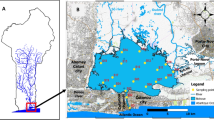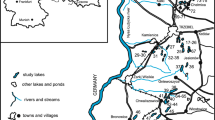Abstract
Studies were conducted at the deepest location of the meromictic Piaseczno pit lake, southern Poland, which was created in abandoned sulphur opencast. Pearson correlation and PCA were used to established the relationship between the elements and physico-chemical parameters of the water, whereas discriminant test to study vertical and time differentiation of Cd, Pb, Sr, Cu, Zn, Mn, and Fe concentrations. The results indicated both vertical (except Cu and Zn) and time differentiations of studied elements in the lake water. The highest concentrations of Cd, Pb, and Sr were found in the monimolimnion, that of Mn and Fe in the anoxic water. Depth profiles of Cu and Zn did not show any pronounced trend. Pb and Sr distributions in the water were related to alkalinity, Cl− and COD, Cd to alkalinity and Cl−, Mn and Fe to the redox conditions, Mn to water pH, and Fe to the alkalinity. The upper (0–15 cm) layer of the sediment consisted mainly of S (24.2 Atom%), Fe (21.62%), Ca (18.4%), Si (14.3%), and (Al 6.3%) and reflected mainly processes proceeded in the anoxic water-sediment interface. Calculated accumulation coefficients (K d) of the elements in the sediment are discussed.
Similar content being viewed by others
References
Albéric, P., Viollier, E., Jézéquel, D., Grosbois, C. and Michard, G.: 2000, ‘Interactions between trace elements and dissolved organic matter in the stagnant anoxic deep layer of a meromictic lake’, Limnology and Oceanography 45, 1088–1096.
Anderson, R. Y., Dean, W. E., Bradbury, J. P. and Love, D.: 1985, ‘Meromictic Lakes and Varved Lake sediments in North America’, USGS Bulletin 1607, 19 p.
Balistrieri, L. S., Murray, J. W. and Paul, B.: 1994, ‘The geochemical cycling of trace elements in a biogenic meromictic lake Geochim’, Cosmochim. Acta 58 (19), 3993–4008.
Buffle, J.: 1988, Complexation Reactions in Aquatic Systems an Analytical Approach, Ellis Horwood Series in Analitycal Chemistry, Halsed Press: A Division of Wiley.
Davison, W., Grime, G. W. and Woof, C.: 1992, ‘Chraracterization of lacustrine iron sulfide particles with proton induced X-ray emmision’, Limnol. Oceanogr. 37, 1770–1777.
Deldon, C. D., Hanselmann, K. W., Peduzzi, R. and Bachofen, R.: 2001, ‘The meromictic alpine Lake Cadagno: Orographical and biogoechemical description’, Aquat. Sci. 63, 70–90.
Deng, Y. and Stumm, W.: 1994, ‘Reactivity of aquatic iron (III) oxyhydrocides – implications for redox cycling of iron in natural waters’, Appl. Geochemistry 9, 23–26.
Fevert, T.: 1987, ‘Heavy metal in alke Kinneret (Israel). II. Hydeogen sulfide dependent precipitation of copper, cadmium, lead and zinc’, Arch. Hydrobiol. 109, 1–24.
Frankiewicz, A. and Pucek, T. R.: 2006, ‘Hydrogeological and hydrochemical characteristics of the flooded sulphur opencast Piaseczno in south-eastern Poland, Mine Water and Environment’.
Hoeft, S. E., Lucas, F., Hollibaugh, J. T. and Oremland, R. S.: 2002, ‘Characterisation of microbial arsenate reduction in the anoxic bottom waters of Mono Lake, California, and reponse towmixing event’, Geomicrobiology Journal 19, 23–40.
Hoeft, S. E., Kulp, T. R., Stolz, J. F. and Oremland, R. S.: 2003, ‘Sulfide as a chemoautotrophic electron donor for dissimilatory arsenate reduction in Mono Lake, California’, ‘Exobiology Principal Investigators’ Seventh Triennal Science Conference, NASA, 25–29 August 2003, Nasa Ames Res. Center.
Hongve, D.: 1997, ‘Cycling of iron, manganese, and phosphate in a meromictic lake’, Limnology and Oceanography 42, 635–647.
Iwanoff A.: 1998, ‘Environmental impacts of deep opencast limestone mines in Laegerdorf, northern Germany. Mine water and the environment. Internat. Mine Water Assoc. 17, 52–61.
LaKind, J. S. and Stone, A. T.: 1989, Reductive dissolution of goethite and hematite by phenolic reductans. Geochim. Cosmochim. Acta 53, 961–971.
Lienemann, C. P., Taillefert, M., Perret, D. and Gaillard J. F.: 1997, ‘Association ofcobalt and manganese in aquatic systems: chemical andmicroscopic evidence’, Geochim. Cosmochim. Acta. 61(7), 1437–1446.
Mac Gregor, B. J., Taillefert, M., Gaillard, J. F., Stahl, D. A. and Lienemann, C. P.: 1998, ‘Molecular characterization of microbial populations in the water column of a stratified lake (Paul Lake, Michigan) related to chemical zonation’, Mineralogical Magazine, 62(A), 933–934.
Morse, J. and Arakaki, T.: 1993, ‘Adsorption and coprecipitation of divalent metals with mackinawite (FeS)’, Geochim. Cosmochim. Acta. 57, 3635–3640.
Pawowski, S., Pawowska, K. and Kubica, B.: 1985, ‘Sulphur mine in Tarnobrzeg’, Przegld Geologiczny 6, 252–257.
Perret, D., Gaillard, J-F., Doninik, J. and Atteia, O.: 2000, ‘The diversity of naturl hydrous iron oxides’, Environ. Sci. Technol. 34, 3540–3546.
Szarek-Gwiazda, E., Galas, J., Wróbel A., Ollik, M. ‘Surface sediment composition in an inundated opencast sulphur mine (Piaseczno lake, southern Poland)’, Aquatic Ecology.
Taillefert, M., Lienemann, Ch-P., Gaillard, J.-F., and Perret, D.: 2000a, ‘Speciation, reactivity, and cycling of Fe and Pb in a meromictic lake’, Geochim. Cosmochim. Acta 64(2), 169–183.
Taillefert, M., Bono, A. B. and Luther, G. W.: 2000b, ‘Reactivity of freshly formed Fe(III) in synthetic solutions and (pore) waters: Voltammetric evidence of an aging process’, Environ. Sci. Technol. 34, 2169–2177
Taillefert, M. and Gaillard, J-F.: 2002, ‘Reactive transport modeling of trace elements in the water column of a stratified lake: Iron cycling and metal scavenging’, J. Hydrol. 256(1–2), 16–34.
Tonolla, M., Demarta, A. and Peduzzi, R.: 1998, ‘The chemistry of Lake Cadagno’, Documenta Ist. Ital. Idrobiol. 63, 11–17.
Turiekien, K. K. and Wedepohl, K. H.: 1961, ‘Distribution of the elements in some major units of the eart's crusts’, Bull. Geol. Soc. Am. 72, 175–192.
Żurek, R.: 2006, ‘Chemical properties of water in a flooded opencast sulphur mine’, Aquatic Ecology in press.
Author information
Authors and Affiliations
Corresponding author
Rights and permissions
About this article
Cite this article
Szarek-Gwiazda, E., Żurek, R. Distribution of Trace Elements in Meromictic Pit Lake. Water Air Soil Pollut 174, 181–196 (2006). https://doi.org/10.1007/s11270-006-9091-4
Received:
Accepted:
Published:
Issue Date:
DOI: https://doi.org/10.1007/s11270-006-9091-4




